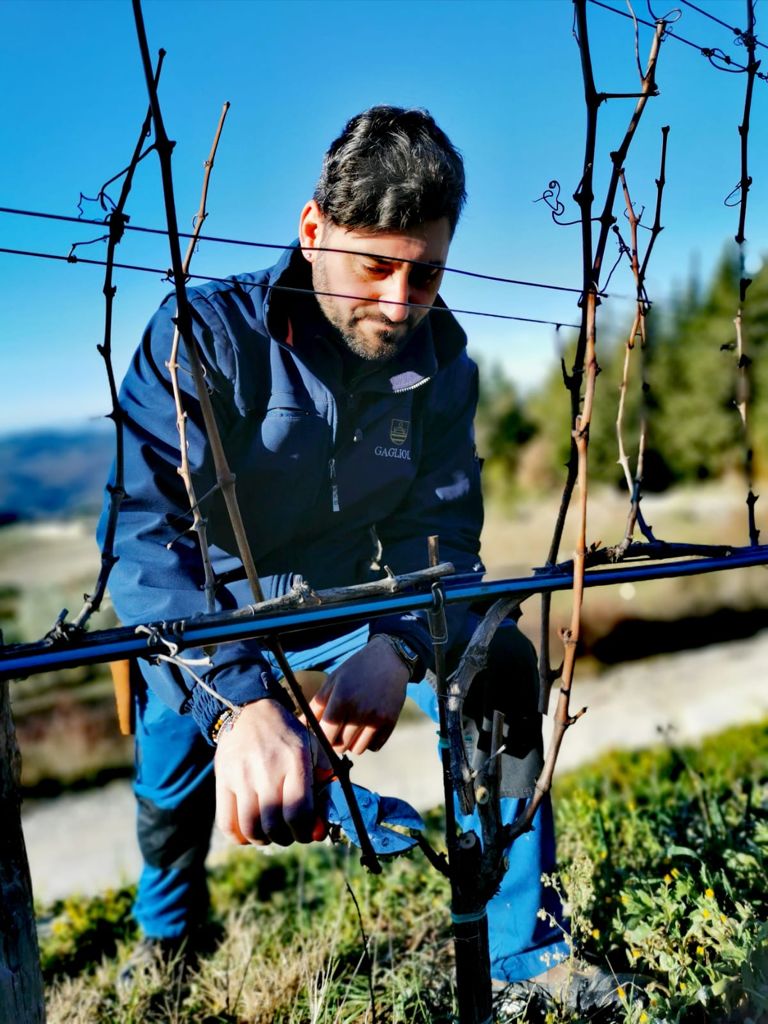During the winter months, nature’s rhythm slows, but there’s still plenty of work to be done in the vineyard. The actual vine pruning season begins between late December and January. Pruning takes place during the dormant winter period when the vine hibernates, and is an essential element of viticulture. The architectural structure of the plant is created in the pruning period and depends upon how the vine is to be trained. In addition, the optimal fruit shoot or spur is selected in order to influence the quality and quantity of grapes that each vine will produce.
Gagliole employee Nicola Mostacci, who plays a leading role in the pruning process, tells us a little more about this fundamental agronomic technique:
Nicola, even if nature’s cycle slows down in winter there are still important jobs to be done in the vineyard, one of which is pruning. Can you tell us more about this agronomic technique which is so essential for the development of the vine’s architectural structure?
With the arrival of the first cold days of autumn and the low winter temperatures, the vine goes into vegetative hibernation throughout the winter. This state is marked by the gradual falling of the leaves, who’s colours first reflect the beautiful shades of autumn, and then slowly fall to the ground. The moment the vine loses its leaves is when it rests for the winter and waits to begin producing again the following spring. Various jobs need to be done in the vineyard at this time of year. But the one winegrowers focus on the most is dry pruning or winter pruning, which is vital as it makes a short or long-term difference to the end result by defining the new production conditions.
Good pruning is essential for the preparation of the following year’s foliage, and to preserve the strength, vitality and durability. Any keen gardener will tell you that pruning is vital to stabilise a plant’s growth – the work carried out now is fundamental for the following season.
What’s the main objective of winter pruning and what do you usually aim for at this stage?
As the vine can produce a certain quantity of fruit depending on the leaf area, we use winter pruning to limit the number of buds on each plant and control the foliage to achieve optimal development and uniform production. This requires intuition and experience. You have to know each vine, each patch of land, each slope… and you have to understand the potential of every plant.
As with any other plant, pruning vines promotes both the quality and quantity of fruiting. The vine bears fruit on one-year-old heads, arising from two-year-old wood. Therefore, the pruner must be able to nurture the annual fruit-bearing canes in the best possible way through pruning, optimising the number of buds and ensuring renewal.
We rely on the Simonit&Sirch pruning method principles for the pruning of the Gagliole vineyards – can you tell us more about this particular and innovative pruning method?
Experience has taught us that following and supporting the vine’s natural tendency for branching through pruning is the key to ensuring a long and healthy life. The Simon&Sirch method is based on this principle. To achieve the best from this method, 4 rules should be applied:
- allow the plant space to grow (centimetres/year) due to the development of controlled branching, avoiding the “return” of foliage points. This allows the plant to take on an increasingly recognisable appearance, which differs according to the cultivation system;
- ensure the continuity of lymphatic flow through the plant structure – the communication component between the roots and crown;
- prune young wood correctly, using small cuts, to reduce the cutting surface and prevent internal drying;
- care should be taken to leave part of the “buffer wood”. This keeps the desiccation area following cutting away from the main sap flow.
How important is training for people involved in pruning?
Five of us deal with pruning the Gagliole vineyards, under the careful supervision of Giulio, who every year guides us through this delicate phase with dedication and passion. Our discussions with Giulio during pruning are vital, as is our training. We need to talk about everything and stay up to date.
What type of vine training is in our vineyards? Does the pruning system vary according to the type of vine training we have?
Italian viticulture is characterised by remarkable soil variety and climate, grape varieties, rootstocks and local traditions, which have contributed to the spread of numerous training and pruning systems.
At Gagliole we use two of the most common training systems in Tuscany: Guyot and Cordon-Trained Spur-Pruned (Cordone Speronato).
Guyot:
This form of cultivation is particularly suited to environmental conditions where the vine has limited development. The trunk is about 100 cm high and a fruit cane of about 8 buds is integrated into this, bent horizontally along the direction of the row, and spurred to 1-2 buds, to provide renewal in the coming years. Three types of cuts are made during production pruning:
- Past cuts – the shoot that produces the fruiting shoots is removed;
- Present cuts – the “spur” shoot is cut to a length of about 7/8 buds;
- Future cuts – another shoot from the spur is spurred to 2 buds and will be the spur that will provide the shoots for the following year’s production.
Cordon-Trained Spur-Pruned (Cordone Speronato)
This is a plant cultivation system that uses short pruning. In practice, the cordon is nothing more than an extension of the trunk of the vine placed horizontally on the supporting wire, also known as the “docking wire”. Spurs (parts of the previous year’s shoots) are left on the back of this extension, that is pruned to two buds so that they can give life to two new shoots, from which the vine will bear fruit.

